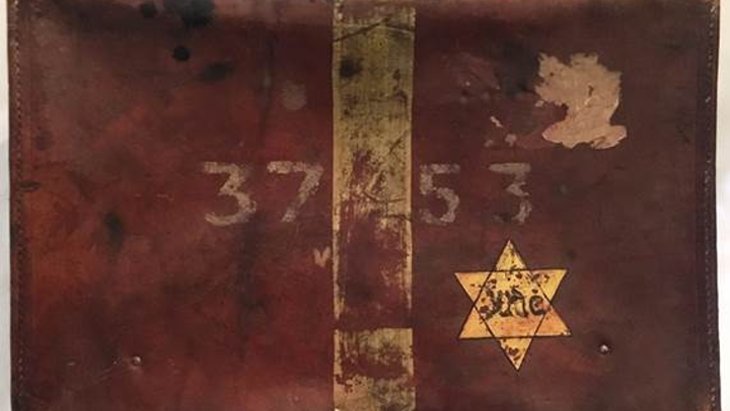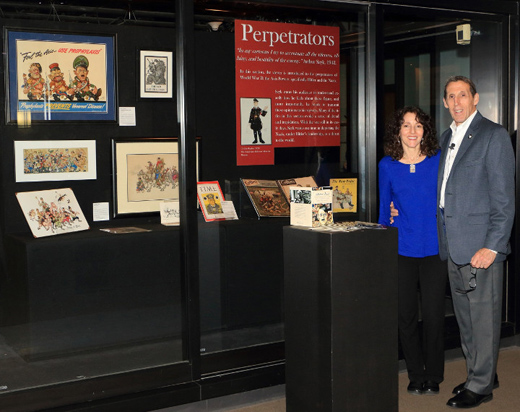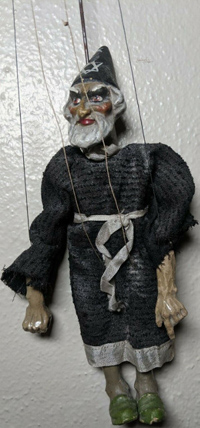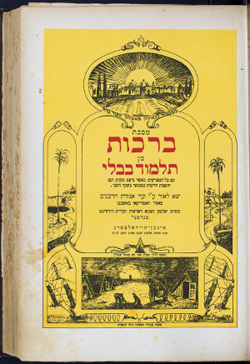
By Judy Gruen
Aish.com

AUSTIN, Texas — The middle school students pass the small brown suitcase from one to another in the school auditorium. They each take a moment to touch its smooth, worn leather, and to look at the six-pointed yellow star that says “Jude” stamped on it. The metal closures are long broken, so that the suitcase is permanently slightly ajar, as if the story of its history is still inside, waiting to be told.
Gregg Philipson regularly brings this suitcase to schools, along with a dozen or so other WWII-related artifacts from his vast collection, to make the Holocaust a bit more real to the next generation. Over the past decade, Philipson, who lives in Austin, Texas with his wife, Michelle Warech-Philipson, has become one of the foremost collectors of WWII-related and Jewish historical artifacts in the country. He is a veritable walking encyclopedia about the Holocaust, Jewish military history, major Jewish figures from nearly all the U.S. wars, including the American Revolution, Civil War and the Confederacy, WWI, WWII, the Korean War, and other U.S. military conflicts. Additionally, his expert knowledge includes the vital role Jewish chaplains have played in the military. Among his more eclectic interests are Jewish magicians, Jewish “strong men,” and Jewish astronauts.

Philipson is a retired executive who worked in the Biometric Authentication Security industry for more than 40 years. Now, in this unexpected second career, he and Michelle travel the country and sometimes internationally, usually at their own expense, so that Gregg can share his vast knowledge on any of these topics, bringing relevant portions of The Gregg and Michelle Philipson Collection and Archive with them.
As a kid, Gregg Philipson collected toy soldiers and baseball cards. But as a young man in his twenties, he discovered the roles that his own father and uncle had played fighting against the Axis powers in WWII. That started him on a quest to collect artifacts that were relevant to his family’s personal history and to Jewish history. Among his first acquisitions were the soldiers’ uniforms that belonged to his father, Sergeant Bernard Philipson, who served with the U.S. Army’s 8th Armored Division and helped liberate the Langenstein Concentration camp, and to his grandfather, Louis Philipson, a U.S. Army sergeant in World War I.
The Gregg and Michelle Philipson Collection and Archive contains a treasure trove of WWII propaganda art that includes cartoons, posters, and even milk bottles imprinted with slogans promoting the sale of war bonds. Some of America’s most famous artists, including Theodore Geisel (later known as Dr. Seuss), used their skills to create posters supporting the war effort. The Walt Disney studios produced posters featuring Mickey Mouse and Donald Duck promoting gas rationing and war bond purchases.
The suitcase Philipson brings to all the schools is a rare artifact. It had belonged to Mere Schomacher Michelson, born on November 25,1848 and killed sometime in 1941 in the Latvian town of Liepāja. The Soviet Union annexed Latvia in 1940, and in 1941, when the Nazis had begun its campaign against the Soviet Union (Operation Barbarossa), German Nazis and Latvian collaborators murdered nearly the entire local Jewish population, which had numbered about 7,000 before the war. Fewer than thirty Jews survived in Liepāja by the end of the war.
Philipson doesn’t lecture the kids from behind a podium. Instead, he walks through the room as he tells stories of history, handing students artifacts from his collection. “Letting the kids touch things makes it so much more real to them. It personalizes the unfathomable tragedy,” he observed.

Philipson is an inveterate shopper for artifacts. One of his latest purchases is a rare, anti-Semitic marionette puppet. Made in 1933, the doll’s face is painted to depict a Jewish man with a sinister, ghoulish face, wearing a wizard’s hat with a Star of David on it.
“This is an important piece as it illustrates the vile anti-Semitic feeling prevalent throughout Europe prior to the Holocaust. It’s a perfect example of how children learn to hate while watching something as innocent as a puppet show,” he explained.
It requires intense effort to locate, purchase and preserve these artifacts, and it can be emotionally draining. “Collecting, if you do it at a very high level, is a very demanding lifestyle, and it gets quite emotional at times,” he said. “There are nights when I sit in my office at one or two in the morning, crying.”
Philipson wants his collection to help shine a light on what “hate, bigotry, and apathy can do to individuals and to the world in general.” To realize this goal, he loans pieces from his collection for public exhibitions around the United States, including to major museums such as the U.S. Holocaust Memorial Museum in Washington D.C., as well as universities, colleges, schools, and U.S. military installations. In 2012, former Texas Governor Rick Perry appointed Philipson a Commissioner to the Texas Holocaust and Genocide Commission. For many years Philipson also served as an advisory board member at the Holocaust Museum in Houston. He is a life member of the Jewish War Veterans.
Though Philipson speaks to audiences ranging from middle school kids to the elderly, his target audience is young people, “not only middle and high school students, but also U.S. soldiers who are still very young and impressionable,” he explained. Several times a year, he addresses the U.S. Army troops at Ft. Hood and speaks on various topics, including the Holocaust. The Philipsons are currently in the process of gifting Jewish Chaplaincy artifacts to the U.S. Army Chaplain Corps Museum, located at Fort Jackson, South Carolina.
With more schools integrating anti-bullying initiatives into their curricula, Philipson’s presentations to thousands of students a year augment what they are learning. “We tie in the lessons of the Holocaust to bullying. We say, ‘Be an upstander, not a bystander.’
A thank you letter he received from a middle school girl said, “I’m glad that you brought things that . . . belonged to people because it really opened my eyes and put things into perspective. There was something about touching and seeing the suitcase, armband, and concentration camp uniform with the star that made it all more real and sad. Because of you coming to our school, I will now try to take nothing for granted. So thank you for teaching us about his horrible time and for teaching me just how lucky I really am.”
Philipson often recommends the book, The Diary of Petr Ginz, written by a teenager whose diary was found in Theresienstadt, to students. Like The Diary of Anne Frank, this diary was also written by a teenager.

The Collection includes three volumes of “The Survivors’ Talmud” – also known as the U.S. Army Talmud – the first and only known edition of the Talmud published by a government body. Two survivors of the Dachau concentration camp, Rabbi Samuel A. Sneig, chief rabbi of the U.S. Zone, and Rabbi Samuel Jakob Rose, proposed the idea of printing an entire, full-size Talmud in Germany as a sign of the Jewish people’s survival despite efforts to annihilate them, and the U.S. government agreed. It was difficult to even find a complete set of Talmud in Western Europe after the Nazi destruction of Jewish lives and property. Finally, two complete sets were found in New York and sent to Germany for the project.
While Philipson has spoken to hundreds of audiences, among his most gratifying experiences have been in China, at Harbin University as well as The Japanese Unit 731 Criminal Evidence Museum, both located in the city of Harbin, and the Shanghai Ghetto Jewish museum, which is located at the former Ohel Moshe Synagogue in the Tilanqiao Historic Area of China. Philipson has what he calls a “powerful” Shanghai ghetto collection and material about the Mir Yeshiva.
“The Chinese are among the most gracious group of people I have ever encountered in all my travels,” Philipson said. “They truly embrace the Jewish people and made us so very welcome. The trip was mutually beneficial as I learned a great deal about the history of Holocaust-era Japanese biological and chemical warfare experiments that were carried out on the Chinese civilian population. The Japanese atrocities across Asia during World War II have many similarities to the Holocaust.”
Because of these similarities, Philipson noted that the Chinese people have a growing interest in Holocaust history. Not only does the Chinese government protect the old Jewish synagogues and other Jewish-related buildings, keeping them in meticulous condition, but “the Chinese people cherish their history of providing safe haven for Jews,” he noted.
This history long predates WWII. “In the early 1900s, many Russian Jews fleeing pogroms were welcomed in Harbin. And Shanghai continued to be a safe haven during the Holocaust. Almost all the members of the famous Mir Yeshiva in Lithuania were able to reach Shanghai and survive.”
With anti-Semitism on the rise again, ugly stereotypes about Jews and vicious slurs against the State of Israel are gaining traction. Philipson’s collection not only works to combat those stereotypes, but to highlight Jewish contributions to anti-racism efforts. His collection includes memorabilia about Rabbi Abraham Joshua Heschel, a civil rights activist who marched with Dr. Martin Luther King Jr. in Selma, Alabama in 1965. Philipson attends U.S. Army observances on topics that commemorate Black history, women’s history, women in the military, women’s equality, and Asian Americans/ Pacific Islander history.
“We have powerful collections on many ethnic groups and set up the exhibits for these events at Ft. Hood as well. Our audiences know we’re Jewish and they love how inclusive we are. I really try to talk about the Jewish experience in America, because we are a people who not only contribute to society as a whole, but we’ve also maintained deep awareness of our Jewishness. We’re saying, be proud of being an American, be proud of being a Jewish American, be proud of who you are and be respectful to others. The audience really gets the message.”
*
Preceding republished with permission from aish.com. Judy Gruen is the author of several books, including the memoir The Skeptic and the Rabbi: Falling in Love with Faith. Her work has appeared in the Wall Street Journal, Chicago Tribune, Los Angeles Times, Boston Globe, Jewish Action, and many other media outlets. She is also a writing coach and book editor. Read more about her at www.judygruen.com.